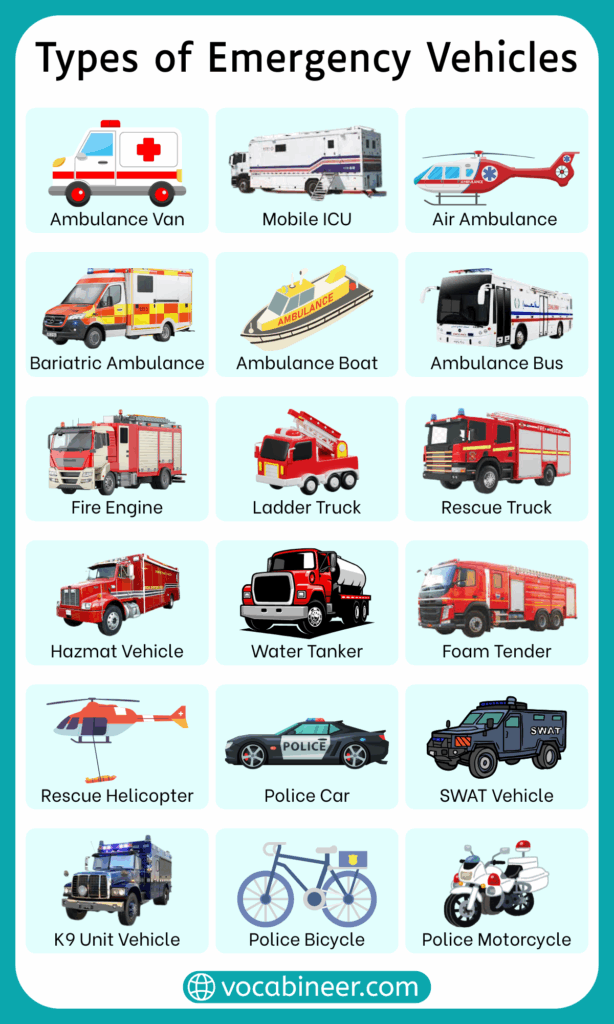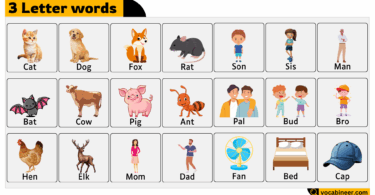The types of emergency vehicles include police, fire, ambulance, and special-purpose units. Each one is built for rapid response, rescue, or protection during emergencies. From flashing lights to loud sirens, they are designed to stand out when every second matters. In this post, you will learn the names of these emergency vehicles with their types. This makes it easier to recognize them in daily life, news, or safety training.
In This Page
Names of Police Emergency Vehicles
Police emergency vehicles are designed for law enforcement work. They support patrols, traffic control, special operations, and rapid intervention.
- Patrol Car: Standard vehicle used daily for law enforcement and traffic duties.
- Motorcycle Unit: Agile option for navigating traffic or escorting events.
- SWAT Vehicle: Armored transport for tactical team deployment.
- Police Van: Used for group transport, crowd control, or detainee transfer.
- Unmarked Police Car: Plain vehicle used for undercover or surveillance operations.
- Police Bicycle: Common in urban patrols, community policing, and public events.
- Highway Patrol SUV: Larger unit built for speed and highway coverage.

Complete List of Fire Emergency Vehicles
Fire emergency vehicles carry water, hoses, ladders, and rescue gear. They vary depending on the fire situation and location.
- Fire Engine: Standard vehicle with hoses, pumps, and firefighting tools.
- Ladder Truck: Equipped with tall ladders for high-rise rescues.
- Water Tender: Brings water to areas without hydrants.
- Rescue Truck: Loaded with tools for crash and technical rescues.
- Wildland Fire Engine: Designed for rough terrain and forest fires.
- Foam Tender: Used for fuel or chemical fires needing foam suppression.
- Aerial Platform Truck: Hydraulic lift for elevated firefighting and rescues.
- Airport Crash Tender: Powerful unit for aircraft fires and airport safety.
Types of Ambulance Emergency Vehicles Names
Ambulances provide patient transport and medical care. Different types exist for routine, advanced, and specialized emergencies.
- Basic Life Support Ambulance: Handles general medical emergencies and transport.
- Advanced Life Support Ambulance: Equipped with advanced tools and paramedics.
- Neonatal Ambulance: Specialized for transporting newborns in critical condition.
- Air Ambulance (Helicopter): Flies patients to hospitals quickly.
- Bariatric Ambulance: Built for safe transport of larger patients.
- Mobile ICU Ambulance: Provides intensive care on the move with advanced equipment.
- Patient Transport Ambulance: Used for non-emergency hospital transfers.
Search and Rescue Emergency Vehicles List
Rescue vehicles are used in remote or dangerous areas, supporting missions by land, air, or water.
- Rescue Helicopter: Air rescues in mountains, seas, or disaster zones.
- Mountain Rescue Vehicle: Off-road truck or SUV for rugged terrain.
- Coast Guard Boat: Used for coastal and maritime rescues.
- Hovercraft Rescue Vehicle: Travels on water, mud, or ice surfaces.
- All-Terrain Vehicle (ATV) Rescue: Compact unit for forest or off-road rescues.
- Snowmobile Rescue Unit: Used in snow-covered areas for quick response.
- Search and Rescue Drone (support): Assists teams with aerial search capability.
Disaster Response Vehicle Types and Names
Disaster vehicles bring equipment and command facilities to major emergencies. They are essential in large-scale relief and hazardous situations.
- Mobile Command Center: Acts as a field operations base.
- Hazardous Materials Unit (HAZMAT): Handles chemical, biological, or toxic incidents.
- Disaster Relief Truck: Delivers medical aid, supplies, and logistics.
- Emergency Lighting and Power Unit: Provides backup energy and light.
- Mobile Field Hospital: Offers temporary medical care in disaster zones.
- Urban Search and Rescue Vehicle: Supports collapsed building rescues and heavy rescue tasks.
- Decontamination Vehicle: Provides washing stations for hazardous material exposure.
Specialized Emergency Vehicles Names
Some emergencies require unique vehicles designed for very specific roles.
- Bomb Disposal Vehicle: Carries robots and tools for explosive threats.
- Riot Control Vehicle: Equipped with barriers or water cannons for crowd safety.
- Armored Rescue Vehicle: Protects crews in hostile rescue operations.
- K9 Unit Vehicle: Built for safe transport of police dogs.
- Prisoner Transport Vehicle: Used to securely move multiple detainees.
- Emergency Communication Van: Mobile hub for secure communication in field operations.
- Flood Rescue Boat: Used for evacuations in flood-affected areas.
FAQs about Types of Emergency Vehicles
A patrol car is a marked vehicle used for everyday police duties such as traffic control and responding to calls. Other police vehicles, like unmarked cars, motorcycles, and SWAT trucks, serve more specialized roles.
Fire engines carry hoses and pumps for putting out fires, ladder trucks reach tall buildings, and wildland engines are designed for fighting fires in forests and rough terrain.
Ambulances differ by purpose: Basic Life Support ambulances handle routine emergencies, Advanced Life Support units carry advanced equipment, neonatal ambulances serve newborns, air ambulances transport patients quickly, and ICU or bariatric ambulances provide specialized care.
Many emergency vehicles are equipped with devices that send signals to traffic lights, turning them green in their direction to allow faster passage through intersections.
Move over laws require drivers to slow down or switch lanes when passing stopped emergency vehicles with lights flashing. This keeps responders safe and ensures traffic flows safely around them.
Read More




